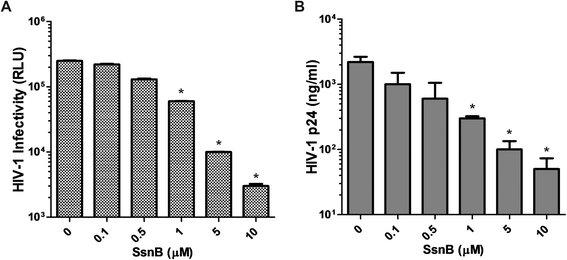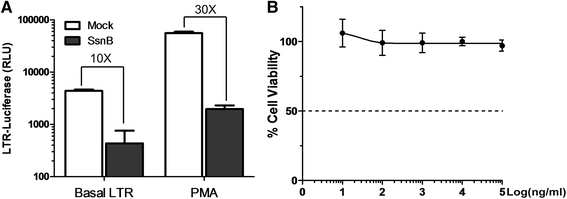The Chinese herb-derived Sparstolonin B suppresses HIV-1 transcription
- PMID: 26206295
- PMCID: PMC4513614
- DOI: 10.1186/s12985-015-0339-8
The Chinese herb-derived Sparstolonin B suppresses HIV-1 transcription
Abstract
Background: The Chines herb derived Sparstolonin B, (SsnB), is a recently identified natural compound that selectively blocks TLR2- and TLR4-mediated inflammatory signaling. But it is unknown whether this compound has any effect on HIV infection.
Findings: We found that SsnB treatment blocked HIV-1 transcription via a novel mechanism that requires the TAR region. Treatment of human T cell lines or peripheral blood mononuclear cells with SsnB at 1 μM significantly inhibited HIV production. Lastly, SsnB was able to inhibit HIV in synergy with AZT.
Conclusions: These data suggest that SsnB is a novel natural compound that inhibits HIV-1 transcription and may be a new drug in the treatment of HIV infection.
Figures



Similar articles
-
[In vitro pharmacodynamics study of an anti-HIV Chinese herbal formulation].Yao Xue Xue Bao. 2010 Feb;45(2):253-6. Yao Xue Xue Bao. 2010. PMID: 21351436 Chinese.
-
[Synthesis and HIV-1 inhibitory activity of natural products isolated from Gnetum parvifolium and their analogues].Yao Xue Xue Bao. 2010 Dec;45(12):1509-15. Yao Xue Xue Bao. 2010. PMID: 21351490 Chinese.
-
Interaction of pregnancy steroid hormones and zidovudine in inhibition of HIV type 1 replication in monocytoid and placental Hofbauer cells: implications for the prevention of maternal-fetal transmission of HIV.AIDS Res Hum Retroviruses. 1997 Sep 20;13(14):1235-42. doi: 10.1089/aid.1997.13.1235. AIDS Res Hum Retroviruses. 1997. PMID: 9310291
-
Natural Products and HIV/AIDS.AIDS Res Hum Retroviruses. 2018 Jan;34(1):31-38. doi: 10.1089/AID.2017.0232. Epub 2018 Jan 10. AIDS Res Hum Retroviruses. 2018. PMID: 29226706 Free PMC article. Review.
-
Review. Drug resistance of human immunodeficiency virus and overcoming it by natural products.In Vivo. 2009 Jan-Feb;23(1):1-6. In Vivo. 2009. PMID: 19368117 Review.
Cited by
-
Forkhead box protein O1 (FoxO1) /SERPINB1 ameliorates ROS production in diabetic nephropathy.Food Sci Nutr. 2020 Dec 20;9(1):44-51. doi: 10.1002/fsn3.1859. eCollection 2021 Jan. Food Sci Nutr. 2020. PMID: 33473269 Free PMC article.
-
Structure-Activity-Relationship and Mechanistic Insights for Anti-HIV Natural Products.Molecules. 2020 Apr 29;25(9):2070. doi: 10.3390/molecules25092070. Molecules. 2020. PMID: 32365518 Free PMC article. Review.
-
SIRT1: A promising therapeutic target for chronic pain.CNS Neurosci Ther. 2022 Jun;28(6):818-828. doi: 10.1111/cns.13838. Epub 2022 Apr 9. CNS Neurosci Ther. 2022. PMID: 35396903 Free PMC article. Review.
-
Herbal medicines and nonalcoholic fatty liver disease.World J Gastroenterol. 2016 Aug 14;22(30):6890-905. doi: 10.3748/wjg.v22.i30.6890. World J Gastroenterol. 2016. PMID: 27570425 Free PMC article. Review.
-
Sparstolonin B exerts beneficial effects on prostate cancer by acting on the reactive oxygen species-mediated PI3K/AKT pathway.J Cell Mol Med. 2021 Jun;25(12):5511-5524. doi: 10.1111/jcmm.16560. Epub 2021 May 5. J Cell Mol Med. 2021. PMID: 33951324 Free PMC article.
References
-
- McDougal JS, Mawle A, Cort SP, Nicholson JK, Cross GD, Scheppler-Campbell JA, et al. Cellular tropism of the human retrovirus HTLV-III/LAV. I. Role of T cell activation and expression of the T4 antigen. J Immunol. 1985;135(5):3151–62. - PubMed
-
- Qiu C, Xu X. H. Z. Pharmacology and clinics of Chinese material. Medica. 2008;14.
Publication types
MeSH terms
Substances
LinkOut - more resources
Full Text Sources
Other Literature Sources
Medical

